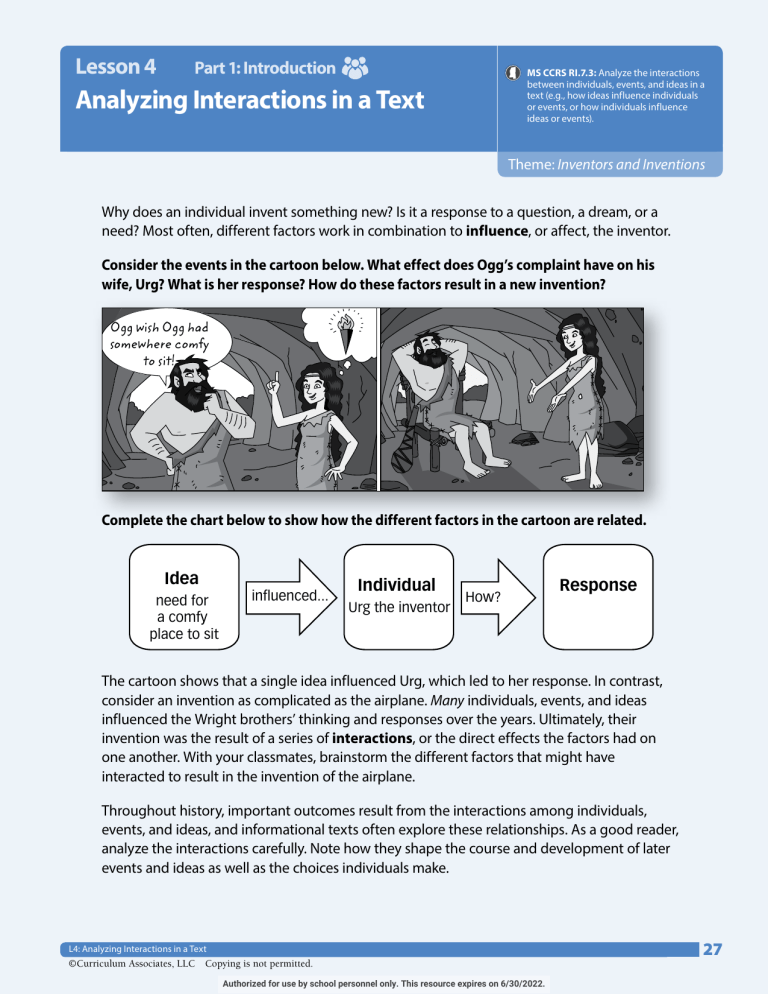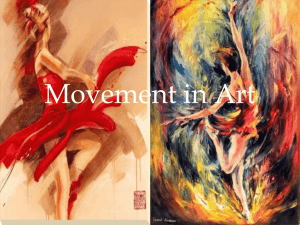
Lesson 4 Part 1: Introduction MS CCRS RI.7.3: Analyze the interactions between individuals, events, and ideas in a text (e.g., how ideas influence individuals or events, or how individuals influence ideas or events). Analyzing Interactions in a Text Theme: Inventors and Inventions Why does an individual invent something new? Is it a response to a question, a dream, or a need? Most often, different factors work in combination to influence, or affect, the inventor. Consider the events in the cartoon below. What effect does Ogg’s complaint have on his wife, Urg? What is her response? How do these factors result in a new invention? Ogg wish Ogg had somewhere comfy to sit! Complete the chart below to show how the different factors in the cartoon are related. Idea need for a comfy place to sit influenced... Individual Urg the inventor How? Response The cartoon shows that a single idea influenced Urg, which led to her response. In contrast, consider an invention as complicated as the airplane. Many individuals, events, and ideas influenced the Wright brothers’ thinking and responses over the years. Ultimately, their invention was the result of a series of interactions, or the direct effects the factors had on one another. With your classmates, brainstorm the different factors that might have interacted to result in the invention of the airplane. Throughout history, important outcomes result from the interactions among individuals, events, and ideas, and informational texts often explore these relationships. As a good reader, analyze the interactions carefully. Note how they shape the course and development of later events and ideas as well as the choices individuals make. L4: Analyzing Interactions in a Text ©Curriculum Associates, LLC Copying is not permitted. Authorized for use by school personnel only. This resource expires on 6/30/2022. 27 Part 2: Modeled Instruction Lesson 4 Read the first paragraphs of the historical account about the photographer Eadweard Muybridge. Genre: Historical Account Flying Horses by Cynthia Hernandez Do horses fly? Intelligent, well-educated people were still asking this question at the end of the nineteenth century. Although the age of believing in winged horses had long since passed, people still wondered if a horse ever lifted all four hooves off the ground at the same time. If someone could prove that a horse’s hooves left the ground, then the answer would indicate that, yes, in a sense, horses do fly! Eadweard Muybridge, photographer and adventurer, put an end to years of speculation. Through the use of a new technology, photography, he laid the question to rest at last. In 1872, Muybridge was working as a photographer in San Francisco when Leland Stanford, former California governor, hired Muybridge to photograph his racehorse. Stanford wanted to know if all four hooves of a trotting horse actually leave the ground, even for an instant. Muybridge rapidly hatched a plan. Unfortunately, his early efforts were unsuccessful. (continued) Explore how to answer this question: “What people, events, and ideas led to Muybridge’s plan to photograph a horse?” Think of the way the question about horses influenced Muybridge’s actions. Fill in the chart below with the idea that led to Muybridge’s response. Response Idea Individual influenced... Eadweard Muybridge How? Caused Muybridge to photograph Stanford’s horse How did people, events, and ideas influence Muybridge’s plan? On the lines below, explain the interaction among the factors. Support your ideas with evidence from the text. 28 L4: Analyzing Interactions in a Text ©Curriculum Associates, LLC Authorized for use by school personnel only. This resource expires on 6/30/2022. Copying is not permitted. Part 3: Guided Instruction Lesson 4 Continue reading about Eadweard Muybridge. Use the Close Reading and the Hint to help you answer the question. Close Reading (continued from page 28) How did Muybridge’s ideas about photography and cameras help him figure out how horses moved? Underline the sentence that explains what his high-speed photographs revealed. Hint After several attempts, Muybridge finally succeeded in getting the proof Stanford needed. Muybridge set up a series of cameras in a line down the side of a horse track. As the horse passed by, its hooves snapped wires stretched across the track, which activated the camera shutters. A series of high-speed photographs resulted. The results amazed the public. The photographs showed clearly that a trotting horse had all four hooves off the ground at the same time. The pictures were a sensation, and Muybridge became an international figure. His successful camera techniques led him to photograph other animal movements too fast for people to see. Circle the correct answer. Which answer choice best describes the images caught by the cameras? Which sentence from the text best explains why the evidence provided by Muybridge changed the public’s thinking about horses? A “Stanford wanted to know if all four hooves of a trotting horse actually leave the ground, even for an instant.” B “Muybridge set up a series of cameras in a line down the side of a horse track.” C “The photographs showed clearly that a trotting horse had all four hooves off the ground at the same time.” D “His successful camera techniques led him to photograph other animal movements too fast for people to see.” Show Your Thinking Explain why the answer you chose illustrates the effect that Muybridge’s photographs had on people’s ideas about horses. With a partner, discuss how Muybridge’s knowledge about the new technology of photography influenced events in his life as well as the thoughts and actions of others. L4: Analyzing Interactions in a Text ©Curriculum Associates, LLC Copying is not permitted. Authorized for use by school personnel only. This resource expires on 6/30/2022. 29


